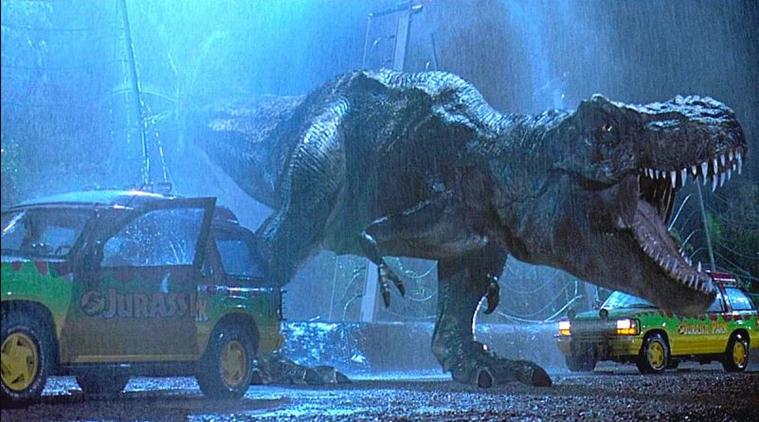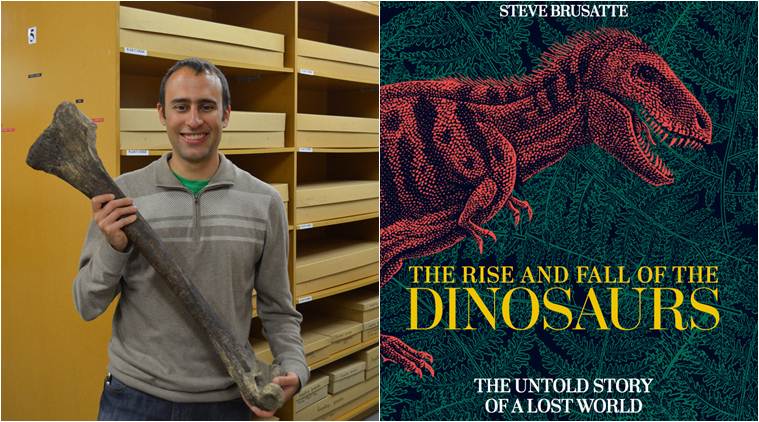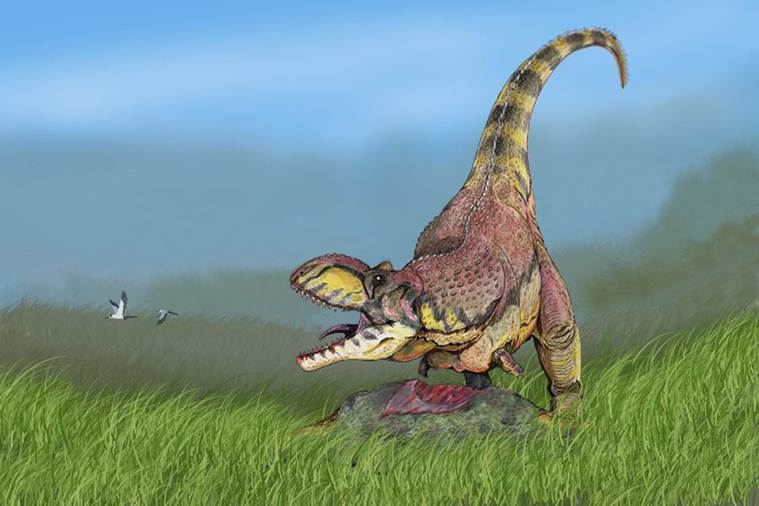 The T-Rex in a still from Jurassic Park.
The T-Rex in a still from Jurassic Park.
American paleontologist Steve Brusatte is a dinosaur expert who likes nothing more than digging up fossils of these long-dead reptiles that were once found all over the world. Recently, he wrote a book ‘The Rise and Fall of the Dinosaurs: The Untold Story of a Lost World’, detailing the reign of dinosaurs from the Triassic to Jurassic to Cretaceous periods that together make up the Mesozoic Era, The Age of Reptiles. He interacted with indianexpress.com over email about the inaccuracies in dinosaurs’ depiction in Jurassic Park films, the expansion of our knowledge about them, the consequences of genetically recreating them and Indian dinosaurs.
Q. Was Jurassic Park an influence on you? I read somewhere about how the film inspired many kids to take an active interest in dinosaurs and the field of paleontology. Some even switched careers after watching it.
It was a huge influence. I still remember going to the cinema to see the film with my father and brothers. I was nine years old. It did not make me immediately want to become a paleontologist. But my youngest brother Chris became totally obsessed with dinosaurs after seeing the movie. He turned his bedroom into a dinosaur museum! It was then through Chris that I became obsessed with dinosaurs a few years later.
Q. Since you are an expert on these magnificent prehistoric beasts, can you tell us how Jurassic Park films have fared in terms of accuracy? I understand our knowledge of dinosaurs has been evolved since the original came out? What are the most exciting new things that we have learned?
I love the Jurassic Park films. I do not like to criticize them, because that is unnecessary. They are blockbuster films, entertainment. They are not science documentaries. For the most part, the dinosaurs in the original film were very accurate, based on what was known at the time. But now we know a lot more about dinosaurs, most importantly that many species had feathers! We also know a lot more about their evolution: how they started small and humble and gradually rose up to dominance, and then were an empire for more than 150 million years. This is the story I tell in my new book The Rise and Fall of the Dinosaurs, which I like to think of as the real story of Jurassic Park.
First, Jurassic Park film had no feathers on dinosaurs. The T. rex runs too fast. The T. rex could still eat the little boy even if the boy didn’t move because T. rex had high intelligence and great senses of smell, hearing and vision.
 Steve Brusatte and the cover of his book The Rise and Fall of Dinosaurs.
Steve Brusatte and the cover of his book The Rise and Fall of Dinosaurs.
Q. Can a man really train or become the alpha to a bunch of raptors like Chris Pratt’s character Owen Grady?
It is a crazy thing to think about it. We do know that raptor dinosaurs (dromaeosaurs) were very intelligent animals. They had big brains relative to their bodies, and probably were as smart as many mammals today. So if humans can train dogs and sheep, why not Velociraptors?
Q. Although it is called Jurassic Park, many dinosaurs featured in the movies are not really from the Jurassic era, right?
That’s right. Most of the dinosaurs are Cretaceous in age. So that means they are from the time after the Jurassic Period. T. rex, Triceratops, Velocirpator: they are all Cretaceous. But Brachiosaurus and Stegosaurus are Jurassic in age.
Q. Hypothetically speaking, if technology evolved to a point where you could recreate dinosaurs, would you do it?
This might surprise you, but no, I would not! The dinosaurs already had their time. They dominated the Earth for more than 150 million years, and then they went extinct when the asteroid came down and changed the world so suddenly. Humans didn’t send the asteroid, so it would be arrogant of us to bring back creatures that nature already made extinct. Plus, the dinosaurs lived in such a different world than us. The atmosphere was different, the plants were different. Would they even be able to survive in today’s world? I don’t know.
Q. You were consulted on the movie Walking with Dinosaurs. Are you happy with how the dinosaurs were depicted in the film?
I am very happy. I think the Walking With Dinosaurs film, which was released in 2013, is the most accurate and realistic portrayal of dinosaurs in any movie ever. I think they are the most accurate dinosaurs that have ever been put on any screen: movie, television, internet. Many scientists were consulted on the dinosaurs. The filmmakers at BBC really respected the input of scientists and it paid off. If you want to see what real dinosaurs looked like, how they moved and fed and interacted with each other, watch Walking With Dinosaurs,
 Rajasaurus roamed around the Indian Subcontinent in the Cretaceous period. (Source: Wikipedia)
Rajasaurus roamed around the Indian Subcontinent in the Cretaceous period. (Source: Wikipedia)
Q. Can you tell us anything about Indian dinosaurs? Like how big were they?
I am embarrassed to say it, but I have never been to India. It is one of the places I would most like to visit. I love Indian culture and food, and Gandhi is a hero of mine. I did a report on Gandhi when I was in eighth grade and I would love to visit the places where Gandhi walked. But I would also love to visit for dinosaurs! There are amazing dinosaurs in India. Some of the very oldest dinosaurs from anywhere in the world come from India: little cousins of the long-necked sauropods, which lived during the Triassic Period, when all of the land was connected as one supercontinent. India has some of the first really big long-necked dinosaurs from anywhere in the world. These are from the early part of the Jurassic Period—dinosaurs like Barapasaurus. And there are Cretaceous dinosaurs too. Big predators with sharp teeth like Rajasaurus.